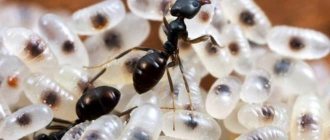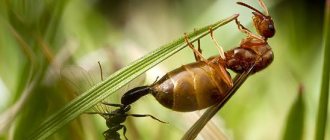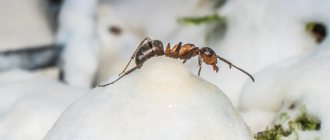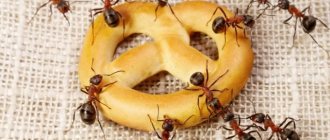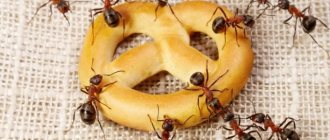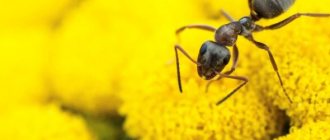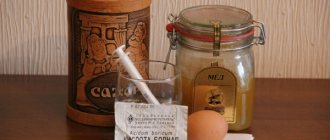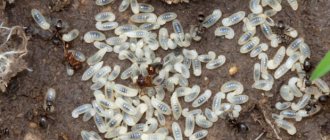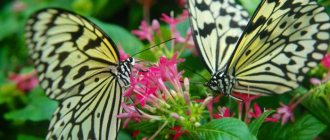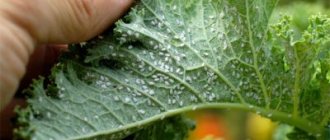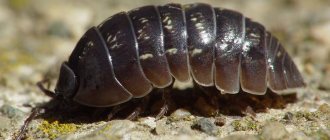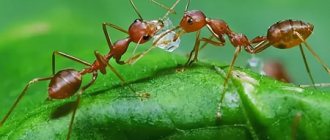Ants belong to the superfamily Antidae of the order Hymenoptera. These amazing insects have existed on the planet since the time of dinosaurs; they create colonies of up to several million individuals. More than 12 thousand species of ants are known, whose total weight is equal to the total weight of all humanity - for every inhabitant of the earth there are a number of ants equal to his weight.
Ants can create symbiosis with plants or other insects, lift a weight several thousand times their own, and also “accelerate” up to 7.6 cm per second, which is approximately 53 km per hour by human standards. These babies are also able to learn by watching others, “hear” with their feet and distinguish each other by smell - each colony has its own. Let's understand the structure of the ant's body to better understand these amazing insects.
Features of the structure of an ant
Insects of the ant family belong to the order Hymenoptera and in their morphology resemble their closest “relatives” - wasps and bees. Different types of ants are very similar in structure, but have some differences depending on their lifestyle or habitat.
The anatomical structure of their body is quite complex. It is perfectly thought out by nature so that these insects have the opportunity to move long distances at good speed, lift heavy loads, attack opponents and defend themselves from natural enemies, and also perform their work functions in accordance with the social hierarchy of the anthill.
Where do they live?
These insects can be seen on all continents, in all climatic zones and regions. They are absent only in sultry deserts, on the cold islands of Iceland and Greenland, as well as in the harsh climate of Antarctica and the Arctic. In regions with cold and temperate climates, insects hibernate in winter.
As a rule, these insects build anthills for themselves in rotten or decayed wood, under small stones or in the ground. Certain species live close to humans or take over other people's nests.
External structure
The body of the ant is covered with a durable chitinous shell. It is divided into 3 main parts - head, chest and abdomen. The diagram of the body structure and anatomy of an ant is presented in the photo.
The chitinous exoskeleton serves to protect against various external damage and is the basis to which skeletal muscles are attached. It is thanks to him that these tiny insects can carry a load several tens of times greater than their own weight.
This is interesting! The smallest species of ants are able to lift objects 50 times heavier than themselves, and larger representatives - only 10-20 times. The smaller the insect, the more powerful it has. It depends on the structure of the muscular system.
Head
On the ant’s head there are two types of eyes (simple and faceted), antennae, as well as a clypeus and mandibles, otherwise called mandibles.
Small but powerful jaws capture and chew food. In the preoral chamber, it is divided into edible and inedible particles.
Most of the space inside the head is occupied by the muscles that control the mandibles. Their largest sizes are recorded in soldier ants. They use them to collect food, clear it of dirt, and also to capture or destroy prey. In addition, such large jaws give them an advantage in battles with opponents, causing significant damage to their enemies.
Eyes
Different species of ants have slightly different organs of vision. Depending on their living conditions and the structure of their eyes, these insects can see only a few centimeters or up to hundreds of meters ahead. And in the soil, for example, absolutely blind ants live.
The visual organs on the head are represented by large compound eyes and three simple ocelli.
The latter are designed to determine the characteristics of the environment, for example, illumination or the plane of inclination of the surface.
The compound eyes of an ant have a complex structure and consist of individual particles - ommatidia. Their outer lenses fit tightly together and resemble the shape of hexagons on the outside, which are called facets. This is where their name comes from.
Despite the complex structure, the ant’s organs of vision have a rather low resolution, so it is quite difficult for insects to distinguish the shape of an object, but they respond well to movement.
Mustache
Ants lack noses, ears and taste buds, but their antennae are a universal sense organ. They are responsible for touch, smell and taste at the same time, and consist of manubrium, flagella and frontal ridges.
Fact! This morphological structure of the antennae is found in nature only in ants.
With their help, insects recognize molecules of various substances, sense air currents and vibrations, and also receive external signals from the environment and other insects. The antennae transmit information to the brain about the tastes, smells and textures of objects around them. Ants can even transfer this data to each other.
The smell is perceived by the flagella of the antennae; insects can distinguish its subtlest shades. And tastes are recognized through numerous plates riddled with pores. Thanks to such unusual sensory organs, ants can distinguish between clean and dirty water, mineral impurities and chemicals in its composition.
For touch and tactile sensations, insects, in addition to their antennae, use small, hard hairs throughout their body.
On a note! Ants, with their antennae, are good at picking up air vibrations and can even predict an earthquake! But they don’t have ears, so they are not able to recognize sound waves.
Communication between insects also occurs through the antennae. Special touches with their flagella, gestures with their paws, combined with the release of pheromones, make up the unique language of ants.
Sternum
The sternum contains the anterior pair of legs and defensive organs. The queen ant and some species of ants also have wings there, which are chewed off after performing the reproductive function.
Between the chest and abdomen there is a kind of “waist” - petiole, which consists of 1-2 segments.
Abdomen
The abdomen contains the heart, reproductive organs, endocrine glands and the main part of the digestive system - the crop and intestines, as well as a toxic chemical substance for attack or defense.
A goiter is a blind extension of the esophagus in which remnants of digested food can be stored. This is the so-called "social stomach" because its contents can be passed on to other members of the nest. Some types of insects even have special individuals - feeder ants, which are responsible for storing food supplies.
Also located here is the main component of the developed endocrine system of ants - Dufour's gland, which secretes special pheromones. With their help, insects communicate and track each other's paths. For example, scout ants look for food, rush to the nest to report information to workers, and then return to the found source by the smell of their tracks.
Important! If you find a lone ant in the kitchen and kill it, most likely other scouts will follow its trail. Therefore, it is important to track its path and rinse everything thoroughly to remove all odors that are elusive to the human nose.
Some species of ants have a sting on their abdomen (an evolutionarily transformed ovipositor), with which you can hit an enemy and inject him with poison. Other varieties have a special hole from which formic acid is sprayed to protect against external danger.
Paws
An ant has three pairs of legs on its body. Each of them is divided into three components - a thigh, a lower leg and a tarsus, which ends in two hook-shaped claws and an adhesive pad. With their help, insects can easily stay on a smooth vertical surface.
Between the body and the leg there is a small hinged mount that connects them to each other - the trochanter. It is so small that it can only be seen under a microscope.
Thanks to this structure of the limbs, ants have high mobility. The front pair of legs can rightfully be considered “hands” in the full sense of the word. With their help, the ant performs different types of work, since they are the strongest.
The secret of strength
It has long been known that ants are very strong and can carry an object whose weight is many times greater than their own. And how much an ant can lift depends on the type of insect. The smallest representatives of the family are able to lift a load 50 times heavier than themselves, while larger species can carry an object weighing only 10-20 times more than they weigh. It turns out that the smaller the individual, the stronger it is. The strength of these weightlifters is explained by the special structure of their muscular system and the presence of a very strong chitinous shell, which performs mechanical and protective functions.
Internal structure of an ant
The internal structure of an ant is very functional. The structure of all organs and systems is thought out by nature to the smallest detail.
- The central nervous system consists of several types of nerve ganglia called ganglia: suprapharyngeal (the largest, performing brain functions), subpharyngeal, thoracic and abdominal. The ant's brain consists of 250-500 thousand neurons and is capable of forming a large number of temporary connections. It has been proven that it is much more developed in socially organized insects living in groups than in solitary individuals.
- Circulatory system
The so-called “blood” of ants is a transparent, colorless liquid - hemolymph. It is not distributed throughout the body in arteries and veins, as in humans, but circulates freely, thanks to the work of a special vessel that acts as the heart. In structure, it is a muscular tube, and runs along the entire dorsal surface of the ant’s body.
- The respiratory system of an ant consists of trachea and spiracles (stigmas), which are located on different parts of the insect’s body: between the mesothorax and epinotum (metathoracic), on the epinotum, on the stalk at the base of the scale and on the abdominal segments. Insects do not have lungs, so the breathing process occurs in a special way - through microscopic pores on the chitinous coating, through which the spiracles pass.
Lifestyle
An ant family is formed over many years, as a result of which the number of inhabited anthills can be several million (these are already colonies located near each other over vast territories). Ant society is divided into three castes: females, males and workers. Taking into account the class, a division of labor occurs, and everyone from the queen to the worker must perform their functions at the proper level (if they fail to cope with their duties, the queen is removed and the worker is killed).
It is not difficult to distinguish representatives of the three castes by external characteristics: while females and males have wings, workers (females with an underdeveloped reproductive system) do not. True, after fertilization, the queen’s wings usually either fall off, or she chews them off for herself, but even in this case, she can be distinguished by her enormous size. While queens and workers emerge primarily from fertilized eggs, which contain the two sets of chromosomes they received from the egg and sperm, males emerge from unfertilized ones. Before turning into an adult, the red, red, black ant goes through the stages of egg, larva and pupa.
Reproduction
All reproduction is carried out in several ways and occurs twice annually.
- During the first method, the queen with a certain number of workers separates from the society and creates a new anthill.
- Another option is a mating flight, in which a female from a foreign anthill is fertilized by several males. Then she lays eggs, from which worker ants are born. Males die after a certain time. Until the workers emerge, the female feeds on the remains of the wing muscles. Females and worker ants are born from fertilized eggs, and males from unfertilized eggs.
These insects are completely harmless, of course, when they do not look after human housing for their place of residence. Therefore, there is no need to simply exterminate them: after all, the ant is an important link in the ecological chain.
Eating
Ants and their larvae are edible and consumed in various parts of the world. The “eggs” (pupae, larvae) of two species of ants from the genus Liometopum serve as the basis for the preparation of a dish known in Mexico as “escamoles”. They are regarded as a form of caviar (or insect eggs) and are sold at a high price, approximately $90 per kg, due to the fact that they are a seasonal and difficult-to-discover resource. In South America (in the Santander department of Colombia), large-bodied ants, known locally as “hormigas culonas” (leaf-cutter ants of the species Atta laevigata), are collected, which are fried alive and eaten.
In various parts of South (India) and Southeast Asia (Myanmar, Thailand), green weaver ant paste is used as a seasoning for vegetable (or meat) curry. Eggs and larvae of weaver ants, as well as their adults, are used in the preparation of Thai yum salad, in a dish called yum khai mod daeng or red ant egg salad (a dish originating from the Isan region in the north). eastern Thailand). Weaver ants are also used as food by the aborigines of Australia (North Queensland). Mexican Indians eat worker ants known as "honey barrels."
How does an anthill work? Life of ants
The lifestyle of ants is very similar to human society: ants, like people, have their own professions.
Look at the structure of the anthill:
- Builder ants and engineers arrange their homes, build tunnels and communications.
- The military, or soldiers, protect the anthill from enemies and seize territory.
- Doctors treat relatives, isolate sick individuals, and, if necessary, perform surgical operations - chewing off damaged paws.
- Nurses look after the larvae.
- Foragers collect food and put it in rooms in the anthill specially designed for this.
- Farmers or livestock breeders are engaged in breeding aphids, cicadas, copperheads, and scale insects. They herd their “animals” and then milk them for delicious honeydew (the sweet secretion of these insects).
- Leaf-cutter ants collect and curl plant leaves, and then grow colonies of fungi from them, which serve as food for the ants. There are also fungus-farming ants, which use pieces of insects or feces to grow mushrooms.
- Harvester ants collect plant seeds.
- Carpenter ants collect the gum that plants secrete.
- Gravedigger ants deliver their deceased ants to the cemetery.
- These interesting insects have other equally interesting professions.
Ant protection
Aneuretus simoni
Although most ant species are resistant to many attempts by humans to eradicate them, some species are at risk of decline or extinction. These are mostly island species that have evolved specialized traits, including Aneuretus simoni from Sri Lanka and Adetomyrma from Madagascar. There are 149 ant species listed on the IUCN Red List of Threatened Species. The eastern liometopum is included in the Red Book of Russia (category 2, a declining species).
By 2009, in 15 constituent entities of the Russian Federation, 30 species of ants were included in the regional Red Data Books (or in the relevant regulations on the protection of rare and endangered species of organisms). In some European countries, the nests of red wood ants are protected and settled. Since 1971, the All-Russian Operation Ant was carried out in the RSFSR to map, protect and resettle beneficial species of forest ants of the genus Formica. In Russia, the destruction (ruin) of anthills is an administrative offense, for which a fine of 300 to 500 rubles or a warning is provided.
What do ants eat?
Another feature of these goosebumps is the ability to adapt to their environment. Therefore, these insects are omnivores. In the spring and summer, food is supplied to the anthill every day by worker ants. With the arrival of cold weather, not all ant families hibernate. As a result, they are forced to stock up on winter food in advance.
Goosebumps distribute food like this:
- The queen feeds exclusively on protein. Very often, food intended for the queen is supplied by worker ants already chewed.
- Worker ants have a carbohydrate diet. This includes the soft parts of berries and fruits, plant juices, their roots and seeds. With particular pleasure they eat honeydew, which is released by the plant during a sharp change in temperature. Another favorite delicacy of goosebumps is the sugar milk of aphids (honeydew). In red forest ants it makes up the majority of the diet. Such food is more nutritious and easily digestible.
- The larvae emerging from the pupa prefer protein foods, which are contained in the remains of small insects, as well as in the eggs of various pests. For example, domestic ants are not averse to eating even the owner’s food: cottage cheese, meat, cheese or eggs. The younger ant generation will not refuse domestic Prussian cockroaches.
Sense organs
On the ant's head there is a pair of eyes, consisting of about six thousand facets - small hexagonal eyes connected directly to the brain. That's quite a bit. For example, the eyes of dragonflies consist of approximately thirty thousand of these facets.
Some ant species also have additional, so-called simple eyes.
. They are located on the parietal part of the head and look like three small black dots.
The structural features of the ant's eye are such that the ant can only look straight ahead and does not see what is happening on the sides. In addition, ants, for the most part, are quite short-sighted.
If we talk about how ants see the world around them, it can be noted that they clearly distinguish only objects that are right under their noses, at a distance of no more than three to four centimeters. Objects located at a distance of more than seven or eight centimeters are already seen as blurred by him.
Insects can detect movement and distinguish large objects at a distance of up to five meters
. Since ants live in their own microcosm, they do not need to see over long distances.
The benefits and harms of ants
The benefits and harm from insects depend on how large their family is and where they live: on a personal plot or in a forest. Garden ants contribute to the enrichment of the soil with oxygen, as they dig their tunnels in the upper layers of the soil.
Humus and remains of organic waste carried by ants into their homes decompose over time, saturating the soil with minerals and making it more fertile. Insects are also plant pollinators: while obtaining nectar for food, they transfer pollen on their abdomens.
Unfortunately, ants contribute to the proliferation of aphids, since they feed on the products of their vital activity, therefore, where there are many of these insects, aphids also live freely, causing enormous damage to the crop.
At the same time, they are capable of exterminating caterpillars and some types of butterfly pests. If ants appear in a human home, they not only cause discomfort, but also eat food, spreading infections and causing allergic reactions.
Forest ants protect trees from parasites, destroying huge populations of them. In addition, by collecting the secretions of certain insects, they protect plants from fungal diseases. But the woodborer is capable of destroying a healthy tree in just a few weeks, making tunnels in its trunk.
This species is also dangerous for garden furniture made of solid wood, since neither paint coating nor pungent-smelling products for treating wood products can scare them away.
Ants secrete a special secretion called formic acid; it is widely used in medicine and pharmacology, and is included in antiseptics, drugs to combat the development of diabetes, arthritis, etc.
If the acid enters the human body in its pure form, it can cause severe anaphylactic shock, which, without timely administration of antihistamines, leads to death.
